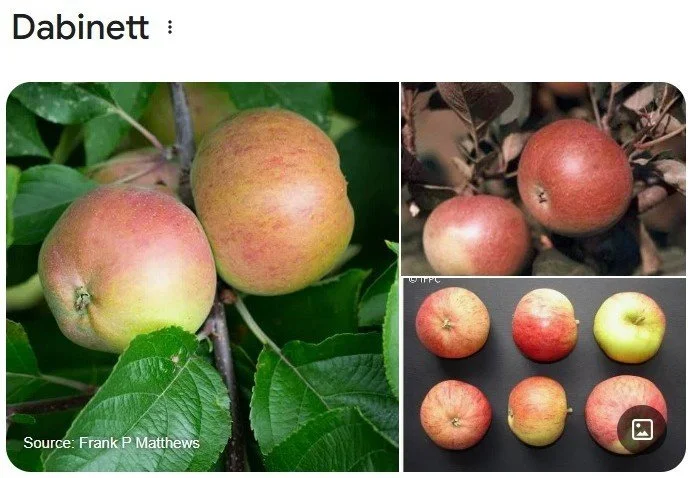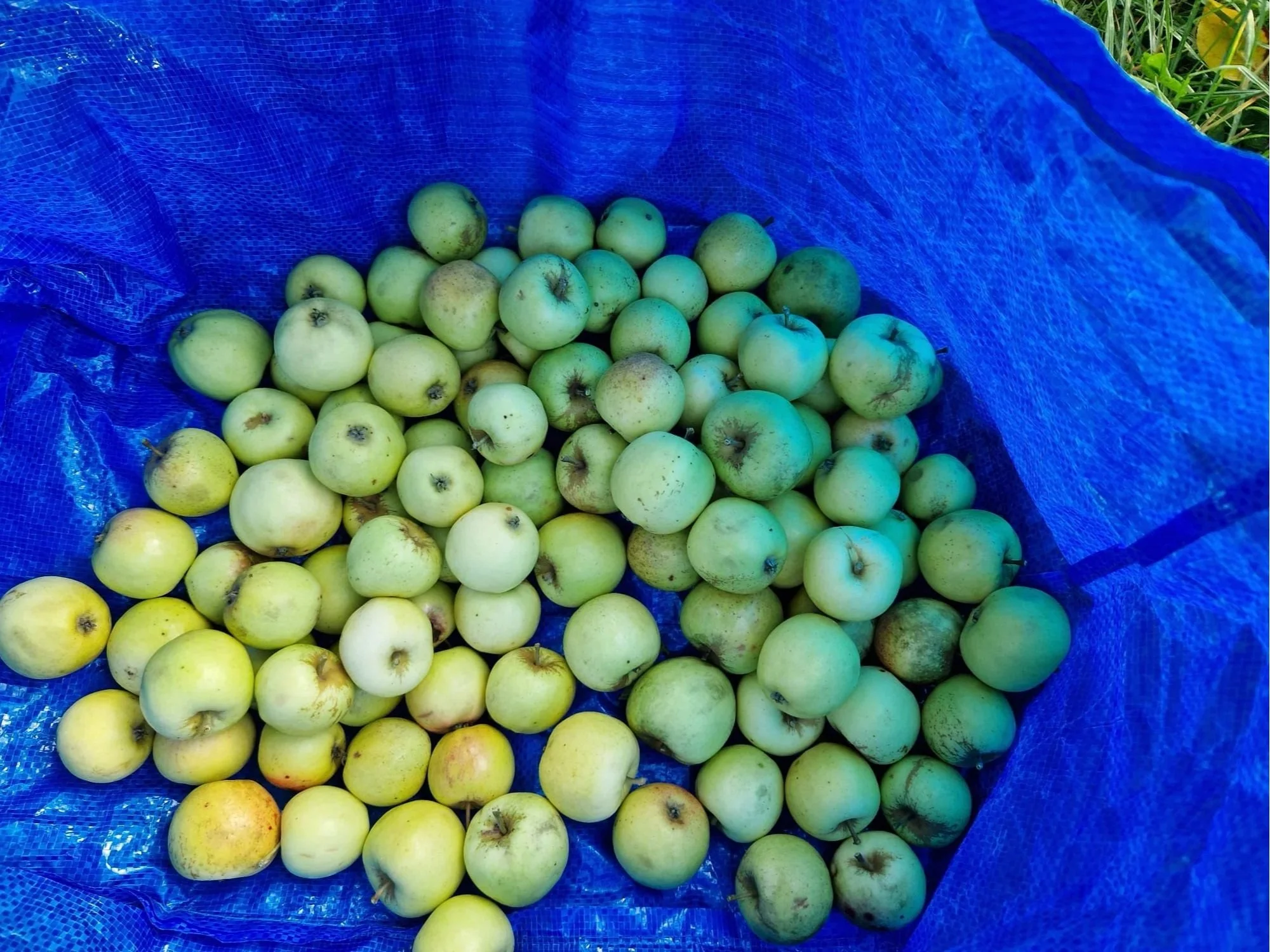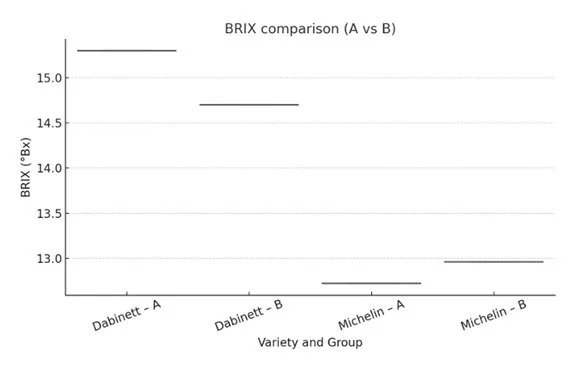Double Blind Cider apple Orchard trial
Background
The aim of this trial is to assess the effect of Channelled Atlantic’s fermented liquid seaweed on two apple varieties Dabinett and Michelin (below) grown at Orchard Farm in Devon.
This trial was set up as a double blind. This means neither us nor the orchard manager knew which side of the orchard had been sprayed. This was important to prevent any biases in the data collection stage. so as you read on, keep in mind we do not know which Group- A or B - has been sprayed with seaweed.
Key points of interest to assess were:
1) scabbing on apples; this is a big factor in determining the profitability of the orchard. If severe, can result in reduced yields as well as affect the sugar content of the apples grown which may lead to the need for the addition of sugars further down the supply chain in the production of cider. Scab presence also impacts costs of fungicide use to minimise scab.
2) Yield; in theory if apples are provided with liquid supplement which contains a broad range of minerals, and compounds to improve vitality and stress resilience, yields should improve.
3) BRIX; this is a measure of plant sugar. Higher plant sugars are indicative of a healthier orchard, and If sugars in the apples are improved this reduces costs along the supply chain.
Methods
Trees were foliar sprayed with 5L/ Ha Seaweed with 300L/Ha water, 3 times over May, June and July.
Yield: 100 apples in each row were collected at random ignoring the first and last 4 trees to ensure apples collected came from sprayed trees. The hundred apples were then weighed.
Scab: The 100 apples collected were then assessed for scab. Scab presence was rated 0-3 in increasing scab presence. The score was transformed into an index, with a lower index meaning the sample had less scab.
BRIX: 3 apples on tree 30 up the row were taken from head, chest, and shin height. They were juiced and mixed to obtain an average BRIX for each row.
Michelin Scab index from 1-3 Dabinett 100 apple count Michelin 100 apple count.
Results
1. Yield (100-Apple Weight)
Both varieities showed an increase in yield in Group A:
- Dabinett: +231 g (≈ +4.5% increase)
- Michelin: +89 g (≈ +2.2% increase)
2. BRIX (Sugar Content)
In Group A Dabinett showed a mild improvement in BRIX of +0.6 °Bx, whereas Michelin showed a reduction in BRIX of −0.24 °Bx.
3. Scab Presence
Both varieties in Group A showed significanlty less scab, −0.23 for Dabinett, and −0.37 for Michelin compared to Group B.
Discussion
The results of this double-blind trial indicate that the seaweed application was performed on Group A, yield was improved, scab was greatly reduced, and one of the varieties showed an improvement in BRIX levels.
The most significant and statistically robust finding in this trial was the reduction in scab severity in Group A. Both varieties demonstrated a clear decline in scab index compared with the untreated control (p < 0.05 for Dabinett, p < 0.001 for Michelin). This points to a strengthened plant immune response, likely due to the elicitor effect of bioactive compounds within the seaweed extract. Reduced disease severity not only improves marketable yield but also offers practical advantages: lower reliance on inputs, reduced labour for sorting infected fruit, and more consistent juice quality for cider production.
The small difference in BRIX levels indicates that the seaweed did not have much of an affect on the sugar levels of the apples. A more likely explanation is that the small sample size of 3 apples per row reduced the likelihood of seeing a change bigger than what we saw.
Confirmation!
After the trial results were presented to the orchard owner, it was confirmed that Group A was indeed the seaweed-treated group. Furthermore, it was revealed that Group B received six applications of fungicide, whereas Group A (seaweed-treated) received only two.
Conclusion
The seaweed treatment improved overall orchard health and reduced scab pressure, while slightly enhancing fruit yield. These results suggest a promising agronomic and financial benefit for growers incorporating seaweed-based biostimulants into cider apple production systems.
This year (2025) has been described as both an “on year” for fruit production and a “mast year,” during which fruiting trees produced substantially higher yields than typical. It is therefore encouraging that, despite these favourable conditions, the seaweed-treated group still demonstrated measurable advantages in the parameters assessed.
The previously unknown reduction in fungicide applications for Group A raises important considerations regarding potential cost savings and the broader impact of fungicides on tree health. If seaweed-based treatments can be used alongside fungicides to improve plant resilience and reduce disease incidence, growers could achieve healthier crops while lowering chemical inputs. Such an integrated approach may enhance the efficacy of existing fungicide programmes while promoting more sustainable orchard management.
Glossary:
Double blind - an experimental design where neither the participants nor the researchers know who is receiving the active treatment versus a placebo (in our case no spray) until the study is over.
BRIX - a unit of measurement for dissolved solids in a liquid, most commonly used to indicate the percentage of sugar by mass. Is also used as a proxy for plant health but varies seasonally.
Elicitor - a molecule that triggers a defense response in plants, such as activating immunity and the production of secondary metabolites
Bioactive compounds - substances found in foods like fruits, vegetables, and whole grains that have a beneficial effect on living organisms, tissues, or cells, but are not essential for life
Statistically significant - a result is unlikely to have occurred by chance and is probably due to a real effect









